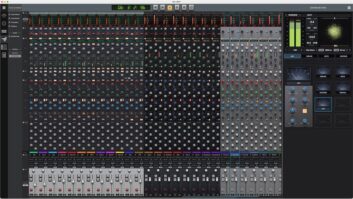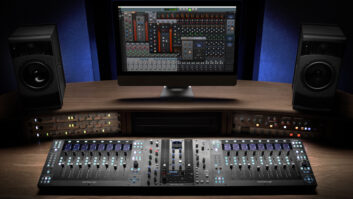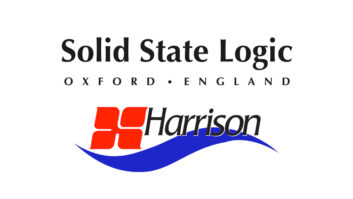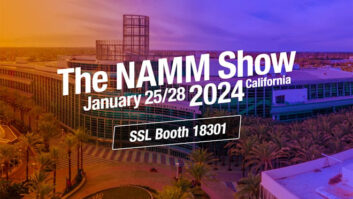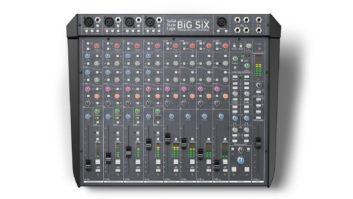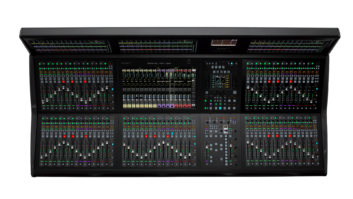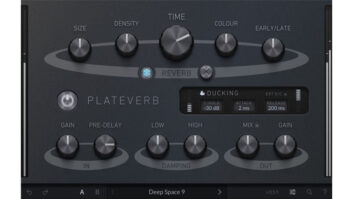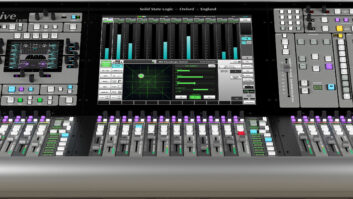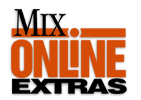
It’s not often that a manufacturer such as SSL produces an entirely
new concept in digital console technology, and it’s even rarer for a
writer to become overexcited about a new console. Yet, both cases are
true with the launch of the C200 Digital Production Console. Designed
for large-format music recording, live-to-air and offline mixing
applications, it’s also flexible enough for new high-ground markets
such as DVD-Audio, multimedia, post-production and even film.
HERITAGE AND PEDIGREE
Sound too good to be true? Yeah, I thought so as well, until I spent
the day at SSL headquarters just outside of Oxford, England, to check
out the C200.

The C200 is an evolution of MT, and takes the concept of the
traditional in-line control surface and marries it with the advantages
of digital technology, such as resetability, automation and lots of
channels. Building on MT’s success and drawing feedback from a host of
users worldwide, SSL has applied what it learned to next-generation DSP
in the form of the Centuri processor core. The new Centuri processing
platform is the first to be used in the C200 and the smaller,
broadcast-oriented C100 console (previewed in last month’s
Mix).
IN-LINE CHANNEL STRIPS
Glancing at the C200’s control surface, everything is right at hand;
like many analog desks, it provides the user with a familiar
operational interface. I reviewed a version with 48 in-line channels;
however, the Centuri processor has enough power to handle up to 96
channels of processing. Though it’s built in physical 8-channel
“bays” (with a minimum setup consisting of two bays, plus
the master control center section), all channels can be accessed
individually. It can also be built in set groups or random combinations
directly from any channel strip if you prefer to remain in the central
master control area.
Banks of channels can be “moved” around the console for
individual functionality at the flick of a switch. The master section’s
large flat-screen monitor display, coupled with the additional
flat-screen displays at the head of each channel bay (showing the
parameter details for that channel bank), not only make the C200 look
impressive, but also directs the user’s eyes to the potential channel
traffic as groups of faders move around. The desk’s bright,
easy-to-read and instructional displays make it the most user-friendly
digital control surface I’ve yet encountered.
In the channel strips, all channels provide 4-band parametric EQ,
high- and lowpass filters, independent compressor/limiter and
gate/expander sections. SSL provides preprogrammed emulations of your
favorite EQ type dedicated to each channel. In addition to the standard
C200 EQ, the console includes E and G Series EQ, and a
“Quad” compressor. Parameter functions can be copied and
pasted from one channel to another or to multiple channels. There are
also 32 user-function EQ settings that can be saved into EQ libraries;
because of the hard drive’s sheer size, an almost limitless number of
libraries can be saved. In real terms, this means EQ settings can be
saved for every track, plus EQ settings from your work on previous
albums could be recalled and used for your next project.
The Centuri core provides matrix I/O options with up to 512 inputs
and outputs at 48 kHz (256 inputs and outputs at 96 kHz). There’s no
actual patchbay with the C200 (though one can be used if required); for
routing, each channel’s external insert point can be assigned to any
analog or digital device, and then switched pre- or post-channel
processing in either the channel or monitor paths. This is indicated
with red (dynamics section) or green (EQ section) LEDs.
The C200 offers global feedback from the channel strip and
associated para-meter settings displayed on the screen above it or the
option for a more in-depth interrogation from additional displays
located in the master control area. Pressing the Set button determines
the flexibility of the signal processing, such as placing the
compressor before the EQ or splitting their functions. This
functionality is shown graphically in a small “process matrix
display,” which provides a color-coded flowchart showing the
dynamics in the channel path or the monitor path. Additionally, the
main master section display shows the dynamics in real-time graphic
mode for an accurate assessment of the data. An 8-character electronic
scribble strip provides a quick-scrolling label for each channel.
MULTIFUNCTION DISPLAYS
Besides the C200’s 48 multitrack buses, there are 12 aux buses. The
auxes can be configured as mono or stereo, and are available
simultaneously from both the large and small fader paths. Aux presets
are available for the more common chores (i.e., headphone foldback,
etc.) and like EQ, aux user presets can be stored in libraries, quickly
recalled, and copied and pasted to other channels or groups of
channels.
Auxes can be flipped to operate with either the large or the small
fader. An A/B button provides channel banking between the small and
large faders. Both large and small faders are touch-sensitive. All are
motorized; the motorized function can be switched off if required.
PANNING AND AUTOMATION
Information is displayed on the scribble strip, the channel display
immediately above the channel, the master control section and the
master control monitor. The buttons on the control surface themselves
are very sensitive to the touch, without being touch-sensitive.
However, with the slightest finger movement, a controlled parameter’s
information is changed in one, two or several displays.
The central display can also show data from an external device via a
standard VGA connection. Therefore, info from Pro Tools, SADiE, Nuendo,
Logic, etc., can be displayed directly on the C200’s central screen
without additional cumbersome laptops or monitors perched and taking up
unnecessary space. The C200’s control tools — the tablet/pen,
mouse and transport/function buttons — are automatically
configured to the specific DAW/sequencer system connected to the desk.
It also accepts RGB signals (with a converter), so the screen could
double as a picture monitor for DVD, television or film production.
Wow!
For straightforward stereo production, a large fader left/right and
a small fader left/right pan is all that you need. To do 5.1, you’ll
need more control: The small fader can be set to handle front/back
panning levels. The 12 main buses can then be combined to form
simultaneous 5.1 program outs, a master 5.1 compressor, a dedicated
master fader and an 8-channel insert point — all easily applied,
stored or recalled.
ROUTING
The 12 buses are displayed in a user-determined matrix with
LCR/Ls/Rs/sub, and Stereo Mix L/Mix R program points. Several surround
and 5.1 presets are also preprogrammed into the matrix, and
user-determined options can be named and stored. This gives
joystick-style control without needing a joystick on the console. SSL
determined that a joystick seems to imply it’s an out-and-out film
console, which the C200 isn’t. But now you know why I originally said
this mixer could be used for post-production and film. SSL user
feedback seems to indicate preferences for the on-screen type of
display; after all, real-time fader movement can be saved, stored and
edited exactly the same way as with a joystick.
The automation can be locally or globally turned on or off, and
changes made in several levels. For example, if you want to mix
simultaneously in 5.1 on the large faders with a stereo mix on the
small faders, you could then globally or individually automate
parameters for full automated 5.1 and stereo panning, and A/B between
the two. This is great for DVD or television production. With a fully
fitted DSP complement, you could have 192 fully automated 5.1 channels
at 96 kHz — scalable in any configuration!
FRAME SIZES
From the routing matrix in the master control section, you can route
to any channel — or range of channels — and patch into the
large fader, the small fader or the insert point for that path. For my
field test, a TC Electronic M5000 and Lexicon PCM90 were controlled. It
was simple to assign the device to a channel or group of channels, and
then control — via the master control section on the C200 —
the effect parameters in real time or through some timecode trigger
function, EDL or MIDI control.
CENTURI PROCESSOR CORE
It’s easy to source an FX device and route the left channel/right
channel across an 8-channel group. When routing, just choose whether
you want the source to “increment” or “sum.”
This is great, because most digital consoles tend to make each task
within the operating system far too complicated to use in real-world
situations.
The C200 can be provided in a frame as small as two bays of 16
channels with a master section, much like the broadcast-oriented C100.
However, as all 96 channels have dedicated buttons within the master
central section — regardless of how many bays are in your frame
— DSP power will determine the number of channels needed. Your
budget and space restrictions will also determine the physical frame
size for your needs. Sure of the C200’s potential, SSL foresees its
multiple uses: in configurations from stage sound, live sound, in the
back of a truck and from a television post console to music production.
It’s even possible to configure the control surface to remove the
central master control area and mount the central monitor on an
external screen. This gives more faders for your space — ideal
for inside a truck perhaps?
The heart of the system is the new Centuri processor, housed in a
15U chassis that hosts up to six DSP cards, each of which can handle up
to 32 channels per card at 48 kHz, but are switchable to 16 channels
per card if used at 96 kHz. The console provides a full 48 mix buses
and 12 aux sends — either at 48 kHz or 96 kHz. I/O card options
cover just about every need, with analog, AES/EBU digital and MADI all
available, operating at 24 bits and with sample-rate conversion for
digital I/O as standard.
FUTURE-PROOF?
In short, whatever your setup, requirements or media application,
you’ll never run out of I/O processing power. SSL even provides a
single card slot for GPI (General Purpose Interface) I/O, with up to 60
GPI inputs and outputs available, so that in a conventional recording
environments, for example, the master control section’s “source
bus” buttons can be used for individual and trigger serial
track-arming and the like.
In addition, the Centuri core’s internal routing card may be fitted
with up to four fiber expansion cards, each daughter card handling up
to four fiber links. This is especially important for live and stage
applications using either the SSL C-SB (C Series broadcast stagebox)
fitted with up to eight inputs per card — 48 mic inputs in total
— with the stagebox placed up to 550 meters from the Centuri
core, or the SSL C-SuperPre (C Series super pre) remote preamp with up
to 24 mic/line inputs and optional insert points for analog processing
before conversion. You can even add optional redundant PSUs for added
resilience, and with up to 16 stageboxes possible using the fiber
links, huge orchestral/scoring sessions should not be a problem.
The Centuri core has an RS-232 port for local processor diagnostics.
In real terms, if your desk ever goes down — the worst nightmare
for any digital console owner — then the SSL’s tech engineers are
only a phone call away, anywhere in the world. Connecting your console
using the SSL NetBridge system (a secure log-in facility) allows techs
to discover and, even more importantly, solve the problem via remote
access. C200 software updates can be uploaded either at a predetermined
downtime or covertly in the background during operation so that the
C200 can expand with new or updated operating systems as they become
available.
According to SSL, a typical studio system starts around $275,000.
However, the C200’s control surface really does match up to just about
everybody’s wish list. Not only does this board offer an entirely new
digital control surface with every bell and whistle, but one with a
tried-and-tested tradition, which end-users helped to determine.
For that reason alone, I expect the C200 to be very successful. It
will live up to its billing because it really does provide everything
that you would want.
Solid State Logic, 212/315-1111, www.solid-state-logic.com.
The former editor of Audiomedia, Rob Alexander is a
musician, engineer, journalist and globe-hopping bon vivant.

Learn about
channel functionality, broadcast control and more.
Examples of the SSL C200’s screens


